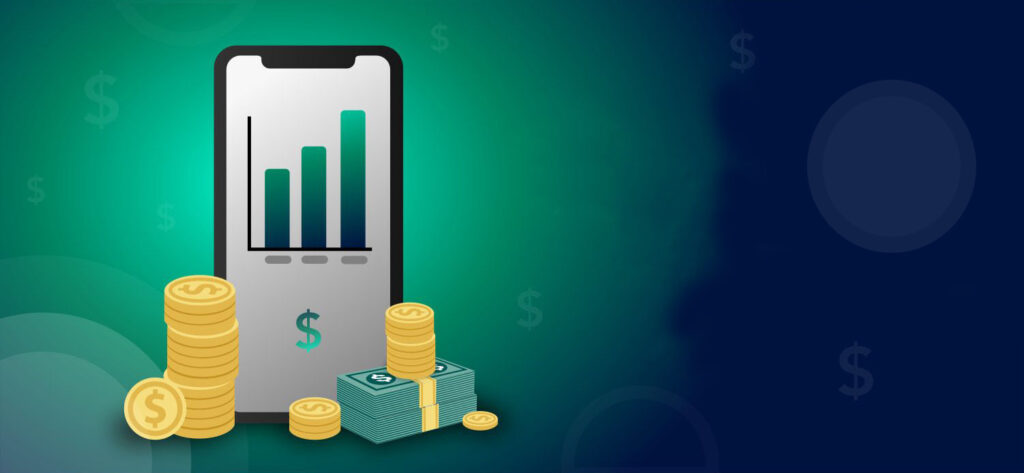The Best Ways To Monetize Your App

The Best Ways To Monetize Your App
In a bar, two app developers stroll in. It sounds like the beginning of a terrible joke, but bear with me. One is a free program, while the other requires a $4.99 download fee. Which one generates the most revenue?
Consider the following: While there are many successful premium applications out there, free apps generate far more revenue on any given week.
Here’s a crash lesson on how to monetize an app and why free applications may or may not be for you if you’re thinking about making one.
Paid apps
Charging for an app is the simplest and most straightforward method to monetise it. The advantage of paid downloads is that you may start making money as soon as customers download your software. The downside is that you’ll have to work more to promote it; most consumers anticipate basic applications to cost 99 cents, so you’ll need tens of thousands of downloads before you start seeing a profit. Expect to pay between $3.00 and $5.00 for utility applications and more sophisticated game apps.



How to Monetize Free Apps
While the allure of premium applications is alluring, the fact is that no one like paying for apps. Unless they really, positively have to. Free apps are the most popular in app stores because they are a win-win situation for both users and developers. Users don’t have to pay anything up front, while developers receive the visibility they need.
Advertisers pay for free applications through display advertisements, or consumers pay for them through ‘freemium’ downloads, in-app sales, or subscription services.
Advertisers pay for free applications through display advertisements, or consumers pay for them through ‘freemium’ downloads, in-app sales, or subscription services.
Display Advertising for Mobile Apps
For mobile app developers wanting to monetize, display advertisements may mean a lot of money. Advertisers paid $13 billion on mobile advertising in 2020, up from $11 billion in 2019, according to the Interactive Advertising Bureau. While the app is opening or in between uses, display advertising range from banner ads (graphic blocks of advertisements) displayed on the top or bottom of the screen to full screen ads (including videos) (between game levels, for instance).
Unfortunately, the popularity of mobile display advertisements is dwindling. Here are the three distinct types of mobile ad models, as well as why marketers are starting to avoid them:
CPC (Cost-per-click or Pay-per-click)- When someone clicks on your ad, you get paid. The issue: On a touch-screen gadget, it’s simply too simple to accidentally click on an advertisement. How many times have you unintentionally “Liked” something or added someone to your Facebook friends list? (No? Is it just me?). Here, too, the same concept applies. CPC (Cost-per-click or Pay-per-click)- – CPM, or cost-per-thousand, is a method of charging advertisers per 1,000 impressions. The issue: An ad ‘impression’ does not always imply that the user sees it. Because of the nature of mobile applications, where users are continuously scrolling or switching views, the CPM model raises concerns about whether advertisers are receiving their money’s value.
CPA (Cost-per-action)– When a user completes an activity, such as filling out a form or making a purchase, you are compensated. The issue is that it diverts people away from your app. It also has an excessive number of steps. Users must first click on the advertisement. They’re then taken to a website that may or may not be mobile-friendly. Then consumers must either fill out their information or leave the advertiser’s website. With so many stages and a mobile keyboard, the likelihood of conversion – and consequently payment – is minimal.
Unfortunately, the popularity of mobile display advertisements is dwindling. Here are the three distinct types of mobile ad models, as well as why marketers are starting to avoid them:
CPC (Cost-per-click or Pay-per-click)- When someone clicks on your ad, you get paid. The issue: On a touch-screen gadget, it’s simply too simple to accidentally click on an advertisement. How many times have you unintentionally “Liked” something or added someone to your Facebook friends list? (No? Is it just me?). Here, too, the same concept applies. CPC (Cost-per-click or Pay-per-click)- – CPM, or cost-per-thousand, is a method of charging advertisers per 1,000 impressions. The issue: An ad ‘impression’ does not always imply that the user sees it. Because of the nature of mobile applications, where users are continuously scrolling or switching views, the CPM model raises concerns about whether advertisers are receiving their money’s value.
CPA (Cost-per-action)– When a user completes an activity, such as filling out a form or making a purchase, you are compensated. The issue is that it diverts people away from your app. It also has an excessive number of steps. Users must first click on the advertisement. They’re then taken to a website that may or may not be mobile-friendly. Then consumers must either fill out their information or leave the advertiser’s website. With so many stages and a mobile keyboard, the likelihood of conversion – and consequently payment – is minimal.
In-App Ads + Mobile Partnerships
Partnering with in-app marketers is an innovative method to add display advertisements into your app to monetize it. This can take the form of a sponsorship (for example, “Sponsored by” or “Brought to you by” followed by the advertiser’s logo) or the integration of their products inside the app. Waze, a social GPS app, partners with stores and merchants to allow them to display their locations and special deals to nearby customers. Similar techniques may be implemented with a little ingenuity and business expertise.
‘Freemium’ Functionality
Here’s a nice little insider tip: after using an app for a while, users are more inclined to pay for it. People usually spend more on upgrading freemium applications than on programmes they can’t get for free, whether it’s because they’ve grown reliant on the app or simply because they can’t put a game down. This is a wonderful method to make money.
How it works:
User downloads free app –> User likes app –> User pays for more features
“Lite” versions: – Calorie Tracker Lite is a free, ad-supported software from LIVESTRONG. If you upgrade to the premium version, the advertisements will be removed. Users also have the option of syncing their information with their web-based account.
Subscription upgrade – Remember the Milk is a free, limited-functioning to-do list that allows users to create and manage activities on the move. Upgrade to enjoy unique features like unlimited auto-syncing across multiple devices, push notifications, and more for $25/year. You may even offer reduced memberships, such as Evernote Premium, which costs $4.99 per month or $47 per year and provides customers increased capacity, offline notes, bigger files, and more.
In-app purchases:Users may buy tokens and other virtual currency and products in Zynga gaming applications to advance in the game, earn more points, or outdo their friends. (Yes, people do purchase virtual stuff!) In 2010, just 10% of the top-grossing games featured in-app purchases; by 2011, that number had risen to 50%, resulting in a roughly 83% increase in total revenue!)
Why it works: Freemium applications have the best of both worlds: they have the same download potential as free apps, but they may use different revenue techniques. As the number of users grows, you may add additional upgrades and capabilities. Most importantly, freemium applications pander to user sensibilities by allowing users to avoid aggressive sales and wait until they are ready to purchase. What are your thoughts? Which monetization method is the most effective for your app?
How it works:
User downloads free app –> User likes app –> User pays for more features
“Lite” versions: – Calorie Tracker Lite is a free, ad-supported software from LIVESTRONG. If you upgrade to the premium version, the advertisements will be removed. Users also have the option of syncing their information with their web-based account.
Subscription upgrade – Remember the Milk is a free, limited-functioning to-do list that allows users to create and manage activities on the move. Upgrade to enjoy unique features like unlimited auto-syncing across multiple devices, push notifications, and more for $25/year. You may even offer reduced memberships, such as Evernote Premium, which costs $4.99 per month or $47 per year and provides customers increased capacity, offline notes, bigger files, and more.
In-app purchases:Users may buy tokens and other virtual currency and products in Zynga gaming applications to advance in the game, earn more points, or outdo their friends. (Yes, people do purchase virtual stuff!) In 2010, just 10% of the top-grossing games featured in-app purchases; by 2011, that number had risen to 50%, resulting in a roughly 83% increase in total revenue!)
Why it works: Freemium applications have the best of both worlds: they have the same download potential as free apps, but they may use different revenue techniques. As the number of users grows, you may add additional upgrades and capabilities. Most importantly, freemium applications pander to user sensibilities by allowing users to avoid aggressive sales and wait until they are ready to purchase. What are your thoughts? Which monetization method is the most effective for your app?
Grow Your Business Today
Build world-class digital products with a team of design, development, and strategy experts. All in one place.






